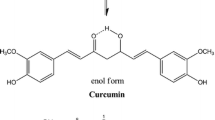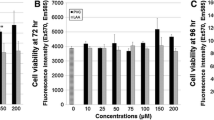Abstract
Monoterpenes are naturally occurring hydrocarbons composed of two units of isoprenes. They exhibit antioxidant activity to scavenge reactive oxygen species, such as hydroxyl radicals. We investigated the potential of monoterpenes such as thymol, linalool, and menthol to act as radioprotectants. The proliferation of EL4 cells, a mouse lymphoma cell line, treated with linalool at a concentration of 500 μM or more was not affected by X-ray irradiation. Plasmid-nicking assay performed using formamidopyrimidine-DNA glycosylase showed that linalool prevented single strand breaks and oxidized purines on pUC19 plasmid DNA. These findings indicate that linalool has the ability to scavenge reactive oxygen species and is a potential radioprotector.




Similar content being viewed by others
References
Roots R, Okada S (1975) Estimation of life times and diffusion distances of radicals involved in X-ray-induced DNA strand breaks or killing of mammalian cells. Radiat Res 64:306–320
Erol FS, Topsakal C, Ozveren MF, Kaplan M, Ilhan N, Ozercan IH, Yildiz OG (2004) Protective effects of melatonin and vitamin E in brain damage due to gamma radiation. Neurosurg Rev 27:65–69
Koc M, Taysi S, Buyukokuroglu ME, Bakan N (2003) Melatonin protects rat liver against irradiation-induced oxidative injury. J Radiat Res 44:211–215
Hofer M, Falk M, Komůrková D, Falková I, Bačíková A, Klejdus B, Pagáčová E, Štefančíková L, Weiterová L, Angelis KJ, Kozubek S, Dušek L, Galbavý S (2016) Two new faces of amifostine: protector from DNA damage in normal cells and inhibitor of DNA repair in cancer cells. J Med Chem 59:3003–3017
Koukourakis MI, Kyrias G, Kakolyris S, Kouroussis C, Frangiadaki C, Giatromanolaki A, Retalis G, Georgoulias V (2000) Subcutaneous administration of amifostine during fractionated radiotherapy: a randomized phase II study. J Clin Oncol 18(11):2226–2233
De La Luz Cadiz-Gurea M, Borras-Linares I, Lozano-Sanchez J, Joven J, Fernandez-Arroyo S, Segura-Carretero A (2017) Cocoa and grape seed byproducts as a source of antioxidant and anti-inflammatory proanthocyanidins. Int J Mol Sci 18(2):376
Lang G, Buchbauer G (2012) A review on recent research results (2008–2010) on essential oils as antimicrobials and antifungals. A review. Flavour Frag J 27:13–39
Wei A, Shibamoto T (2010) Antioxidant/Lipoxygenase inhibitory activities and chemical compositions of selected essential oils. J Agric Food Chem 58:7218–7225
Tomaino A, Cimino F, Zimbalatti V, Venuti V, Sulfaro V, De Pasquale A, Saija A (2005) Influence of heating on antioxidant activity and the chemical composition of some spice essential oils. Food Chem 89:549–554
El-Ghorab A, Shaaban HA, El-Massry KF, Shibamoto T (2008) Chemical composition of volatile extract and biological activities of volatile and less-volatile extracts of Juniper Berry (Juniperus drupacea L.) fruit. J Agric Food Chem 56:5021–5025
Asikin Y, Taira I, Inafuku S, Sumi H, Sawamura M, Takara K, Wada K (2012) Volatile aroma components and antioxidant activities of the flavedo peel extract of unripe Shiikuwasha (Citrus depressa Hayata). J Food Sci 77(4):469–475
Goper PA (1950) Studies in antibody response of mice to tumour inoculation. Br J Cancer 4:372–379
Jenner PM, Hagan EC, Taylor JM, Cook EL, Fitzhugh OG (1964) Research section Food flavourings and compounds of related structure I Acute oral toxicity. Food Cosmet Toxicol 2:327–343
OECD Screening Information DataSet (SIDS) (2002) High production volume chemicals (processed by UNEP chemicals), SIDS Initial Assessment Report For SIAM 14
OECD Screening Information DataSet (SIDS) (2003) High production volume chemicals (processed by UNEP chemicals), SIDS Initial Assessment Report For SIAM 16
Gulston M, Fulford J, Jenner T, De Lara C, O’Neill P (2002) Clustered DNA damage induced by gamma radiation in human fibroblasts (HF19), hamster (V79-4) cells and plasmid DNA is revealed as Fpg and Nth sensitive sites. Nucleic Acids Res 30(15):3464–3472
Tchou J, Bodepudi V, Shibutani S, Antoshechkin I, Miller J, Grollman AP, Johnson F (1994) Substrate specificity of Fpg protein. J Biol Chem 269:15318–15324
Kudo K, Ito H, Ihara S, Terato H (2015) Quantitative analysis of oxidative DNA damage induced by high-voltage pulsed discharge with cavitation. J Electrostat 73:131–139
Kim SH, Nam JH, Park EJ, Kim BJ, Kim SJ, So I, Jeon JH (2009) Menthol regulates TRPM8-independent processes in PC-3 prostate cancer cells. Biochim Biophys Acta 1792:33–38
Wang Y, Wang X, Yang Z, Zhu G, Chen D, Meng Z (2012) Menthol inhibits the proliferation and motility of prostate cancer DU145 cells. Pahol Oncol Res 18:903–910
Kijpornyongpan T, Sereemaspun A, Chanchao C (2014) Dose-dependent cytotoxic effects of menthol on human malignant melanoma A-375 cells: correlation with TRPM8 transcript expression. Asian Pac J Cancer Prev 15(4):1551–1556
Iwasaki K, Zheng YW, Murata S, Ito H, Nakayama K, Kurokawa T, Sano N, Nowatari T, Villareal MO, Nagano YN, Isoda H, Matsui H, Ohkohchi N (2016) Anticancer effect of linalool via cancer-specific hydroxyl radical generation in human colon cancer. World J Gastroent 22(44):9765–9774
Kang SH, Kim YS, Kim EK, Hwang JW, Jeong JH, Dong X, Lee JW, Moon SH, Jeon BT, Park PJ (2016) Anticancer effect of thymol on AGS human gastric carcinoma cells. J Microbiol Biotechnol 26(1):28–37
Ivanova T, Han Y, Son HJ, Yun YS, Song JY (2006) Antimutagenic effect of polysaccharide ginsan extracted from Panax ginseng. Food Chem Toxicol 44:517–521
Hosseinimehr SJ, Tavakoli H, Pourheidari G, Sobhani A, Shafiee A (2003) Radioprotective effects of citrus extract against g-irradiation in mouse bone marrow cells. J Radiat Res 44:237–241
Samarth RM, Goyal PK, Kumar A (2004) Protection of swiss albino mice against whole-body gamma irradiation by Mentha piperita (Linn.). Phytother Res 18:546–550
Archana PR, Nageshwar Rao B, Ballal M, Satish Rao BS (2009) Thymol, a naturally occurring monocyclic dietary phenolic compound protects Chinese hamster lung fibroblasts from radiation-induced cytotoxicity. Mutat Res 680:70–77
Acknowledgements
We thank the staff of Department of Animal Resources, Advanced Science Research Center, Okayama University for use of X-ray generator MBR-1520R. We also thank Ms. T. Terada for preparation of the manuscript. This work was supported in part by the Grant for Strategies for the Efficient Operation of Okayama University.
Author information
Authors and Affiliations
Corresponding author
Rights and permissions
About this article
Cite this article
Kudo, Ki., Hanafusa, T. & Ono, T. In vitro analysis of radioprotective effect of monoterpenes. J Radioanal Nucl Chem 313, 169–174 (2017). https://doi.org/10.1007/s10967-017-5268-0
Received:
Published:
Issue Date:
DOI: https://doi.org/10.1007/s10967-017-5268-0




